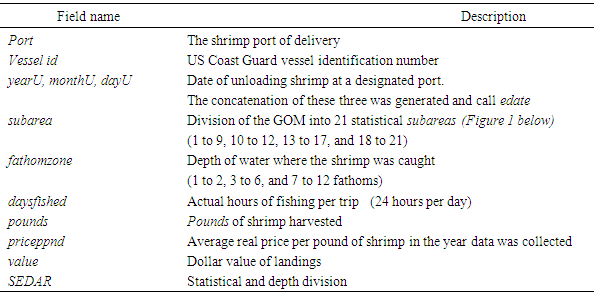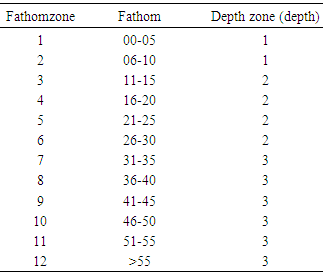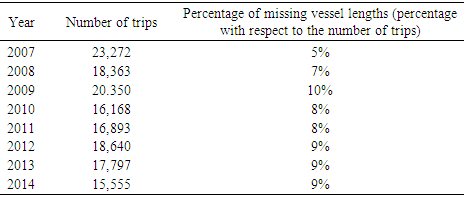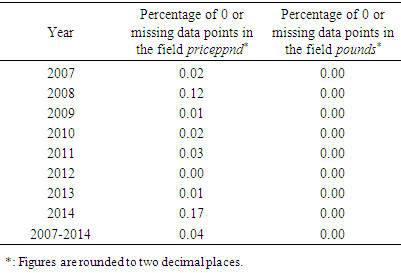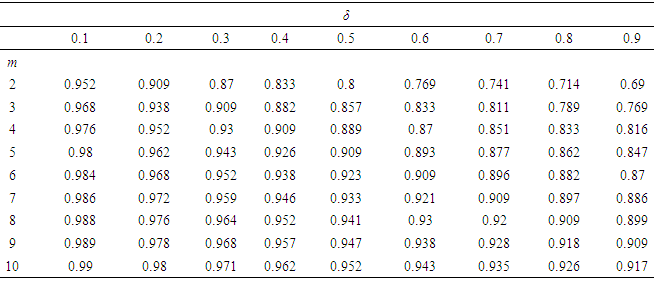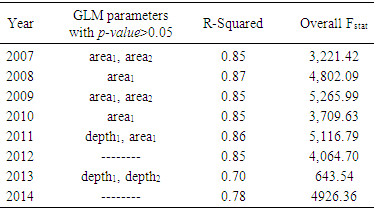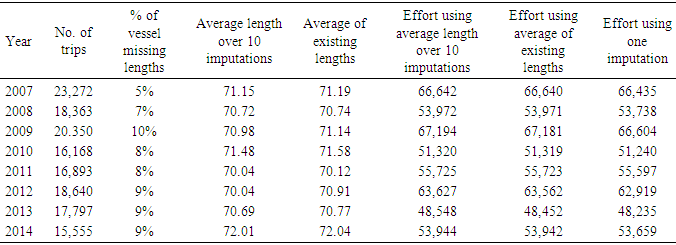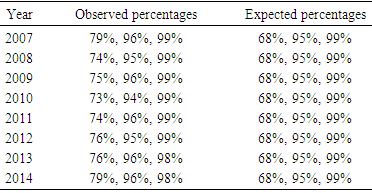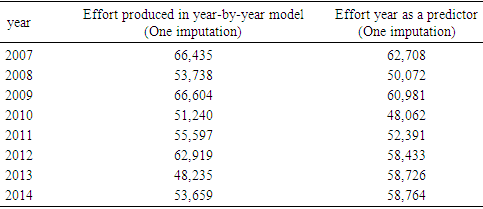-
Paper Information
- Paper Submission
-
Journal Information
- About This Journal
- Editorial Board
- Current Issue
- Archive
- Author Guidelines
- Contact Us
International Journal of Statistics and Applications
p-ISSN: 2168-5193 e-ISSN: 2168-5215
2018; 8(2): 42-52
doi:10.5923/j.statistics.20180802.02

Estimating Missing Values via Imputation: Application to Effort Estimation in the Gulf of Mexico Shrimp Fishery, 2007-2014
Morteza Marzjarani
NOAA, National Marine Fisheries Service, Southeast Fisheries Science Center, Galveston Laboratory, 4700 Avenue U, Galveston, Texas, USA
Correspondence to: Morteza Marzjarani , NOAA, National Marine Fisheries Service, Southeast Fisheries Science Center, Galveston Laboratory, 4700 Avenue U, Galveston, Texas, USA.
| Email: |  |
Copyright © 2018 The Author(s). Published by Scientific & Academic Publishing.
This work is licensed under the Creative Commons Attribution International License (CC BY).
http://creativecommons.org/licenses/by/4.0/

Linear models along with multiple imputation method have become powerful tools for prediction and estimating missing data points. In this research, the collaboration between these two tools will be studied and then the tools will be deployed to estimate shrimp effort (actual hours of fishing per trip) in the Gulf of Mexico (GOM) for the years 2007 through 2014 using a simple form of a general linear model (GLM). Since there was a need for handling missing vessel lengths and the price per pound, multiple imputation method was deployed and missing data points including missing vessel lengths were estimated. An ad-hoc method was also used to estimate the missing vessel lengths and the results were compared with those obtained from the imputation method. As an application, a GLM was developed and used to estimate shrimp effort in the GOM for the years 2007 through 2014. The GLM included a few continuous and categorical variables. Additionally, the model was revised by including year as an independent variable and compared the results with the case of year-by-year estimates.
Keywords: Imputation, General Linear Models
Cite this paper: Morteza Marzjarani , Estimating Missing Values via Imputation: Application to Effort Estimation in the Gulf of Mexico Shrimp Fishery, 2007-2014, International Journal of Statistics and Applications, Vol. 8 No. 2, 2018, pp. 42-52. doi: 10.5923/j.statistics.20180802.02.
Article Outline
1. Introduction
- The primary objective of this research was to address the missing data points and handle those using proper statistical techniques. As an application, a general linear model (GLM) with a few covariates was developed and applied to the shrimp fishery data and estimated the fishing efforts (actual hours of fishing per trip) for the years 2007 through 2014. For estimating missing data points, multiple imputation method was selected and used. The method takes advantage of the Monte Carlo simulation along with statistical models in estimating missing data points [1]. Along with the objective mentioned above, the intention was also to show how imputation would produce compelling results in case of missing data points. General linear models have been addressed by many authors such as [2], for example. There has been (and continue to be) advances made on this topic. The model has been extended to include stepwise regression, logistic regression, and general and generalized linear mixed models among others. There is no need to address this theory again here and it is assumed that the reader is familiar with this concept. Due to the lack of familiarity and/or computational challenges, some researchers have relied on the ad-hoc approaches such as removing or replacing missing data points with the average of the existing points. These approaches may ultimately produce results far from the true values [3] and [4]. Consider a set of an ordered pairs of numbers (x, y) as (2, 6), (3, 7), (4, 8), (5, .), and (6, 10). Notice that the pair before the last is missing the y-component. The average of the existing y values is 7.75. On the contrary, one imputation method produces 9 for the missing value which is a much more reasonable value for the missing data point (given the pattern). It is a fact that replacing the missing value with the average of the existing y values relied only on the y values. The imputation method on the other hand, took advantage of an additional piece of information (that is, the x values) to produce an estimated value for the missing data point. We must use every piece of information available to us when trying to estimate a missing value (s).Many research studies have addressed multiple imputation including [5-9]. Depending on the circumstances, for example, the pattern of missing data points, proper imputation models have been selected carefully and used here. Data for the shrimp effort estimation come from dealers, port agent interviews, United States Coast Guard, (USCG) and Electronic Logbook (ELB) devices installed on vessels. The major data contributors to this research were the following three files: Shrimp data files (2007-2014), AllocZoneLands files (2007-2014), and the United States Coast Guard Vessel file. The Shrimp data file available from the National Marine Fisheries Service (NMFS) is based both upon landings as reported to NMFS port agents by dockside dealers and agent interviews with shrimpers who are in port [10]. The Shrimp data files included several fields of interest to this study. Table 1 gives the fields used in this research and the corresponding descriptions.
|
|
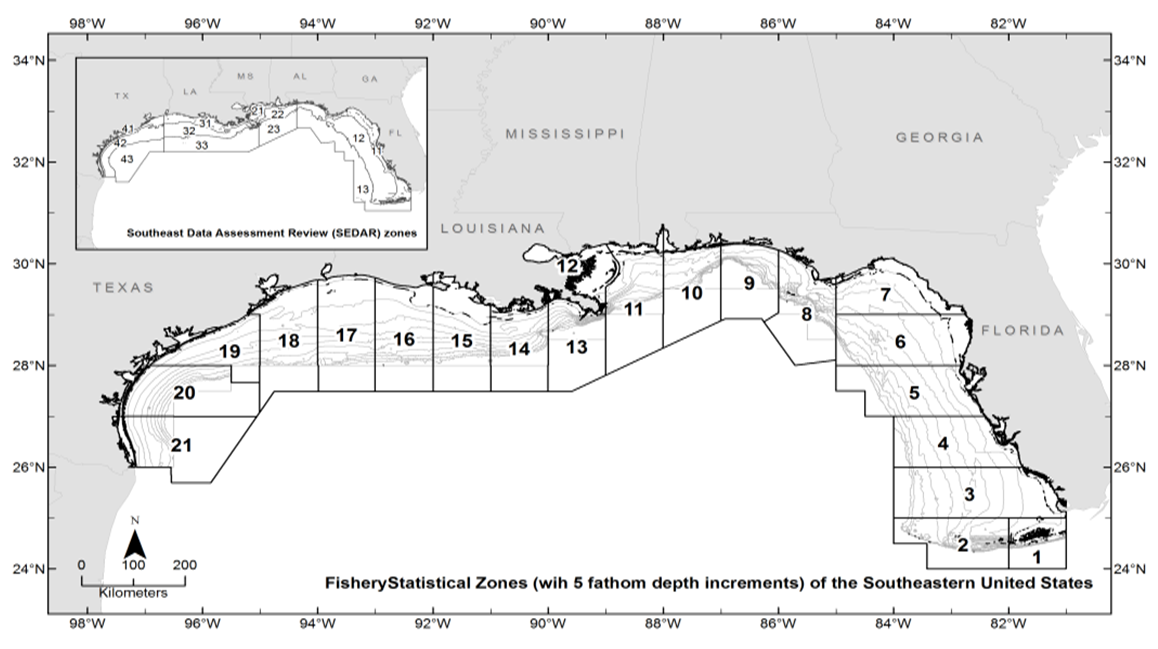 | Figure 1. The Gulf of Mexico is divided into twenty-one statistical subareas (1-21) as shown |
 | Figure 2. Conversion of statistical subareas (1-21) and fathomzones (1-12) in the Gulf of Mexico to areas (1-4) and depths (1-3) respectively |
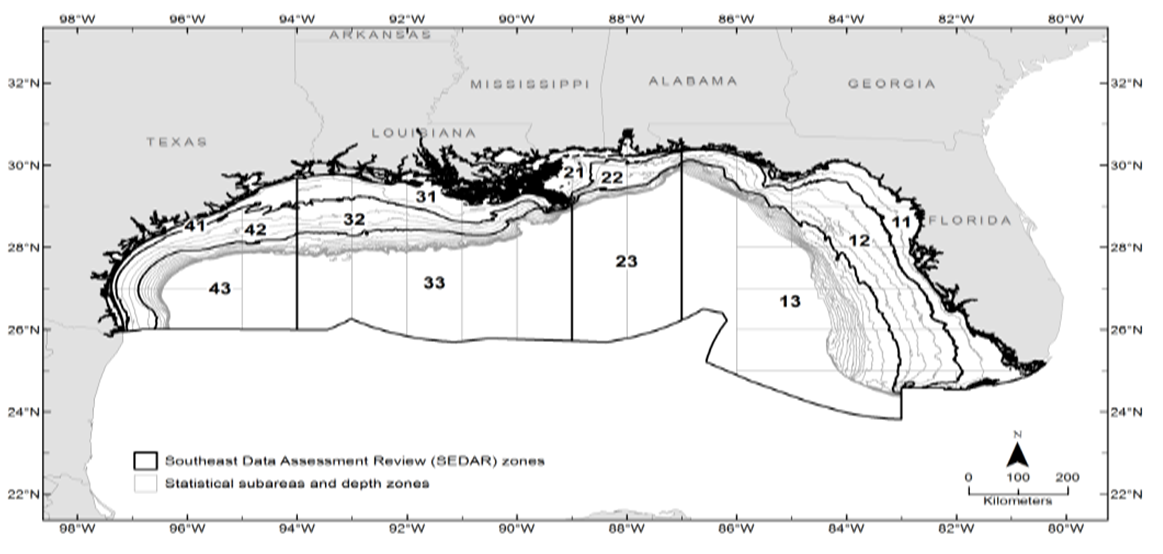 | Figure 3. Combination of areas (1-4) and depths (1-3) in the Gulf of Mexico called SEDAR cells |
2. Method
2.1. Year-by-year
- As described in [12], the following steps were taken to prepare the data for statistical analysis. First, for each year, the offshore data in the Shrimp data file was converted to “Trips” based on vessel id number (vessel), edate (edate), and port (port) along with the weighted average price per pound per trip (wavgppnd) and total pounds per trip (totlbs). In the next step, the three files Trips, AllocZoneLands, and Vessel were matched based on the common fields listed in Table 3 grouped by the zone field from the AllocZoneLands file to create the “Match” file. For the purpose of effort estimation later, the next step was to revisit the shrimp data file and convert it to “Trips” but this time grouped by the SEDAR field. In this research, the calendar year was also placed into three trimesters (January-April, May-August, and September-December).
|
2.2. Year as a Covariate
- Here, the process again involved several steps. First, all the Shrimp files were merged to create one file consisting of 579,818 records (offshore data only). It was decided to impute the files for a few missing data points in the price per pound field prior to merging. The resulting file then was converted to “trips” based on vessel id number (vessel), edate (edate), and port (port). The new file called “Trips” had 82,856 records. At the same time, the weighted average price per pound using pounds as the weight (wavgppnd) and total pounds per trip (totlbs) were computed. Next, all the AllocZoneLands 2007-2014 files were merged creating a new file with 13,908 records. Similar to the case of year-by-year, the three files Trips (created above), new AllocZoneLands, (described above) and the Vessel file were matched based on the common field (s) listed in Table 3 and grouped by the field zone from the AllocZoneLands file. The resulting match file consisted of 61,232 records. For the purpose of effort estimation later, again the appended shrimp files described in the first step was converted to trips using Table 3 and grouped by the SEDAR field. The generated file consisted of 137,039 records (trips). Real datasets often have missing data of one kind or another, an unpleasant reality that must be faced. The variable vessel length (length) was included in the model as a continuous predictor [12]. Due to the inclusion of length in this study, in the next step, the United States Coast Guard file (USCG) was used to locate as many vessel lengths as possible. Table 4 shows the number of trips generated and the percentage of missing lengths in the corresponding Trips files for each year.
|
2.3. Handling Missing Data Points via Imputation
- As mentioned above, in this article, the imputation method was selected as a mean for estimating the missing values. Using this method one can estimate a missing value statistically while considering the variability generated due to the selection of a value for the missing data point [1]. Since missing vessel length pattern could not be predicted from any other meaningful variable such as pounds, it was assumed that the missing pattern here was missing completely at random (MCAR), that is, missingness was not related to any factor, known or unknown [4]. In other words,
 where the vector
where the vector  represented the observed and missing vessel lengths (length), and
represented the observed and missing vessel lengths (length), and  represented the totlbs with all known values and
represented the totlbs with all known values and  a vector with elements 1 if a vessel length was missing and 0 otherwise. For a detailed definition of MCAR, the reader is referred to [14]. The 2008 data with moderate missing vessel lengths (7%) was selected and checked for the MCAR pattern. To confirm the MCAR pattern, Little’s test [15] was applied to the same data set producing χ2 = 0.509 with p-value 0.476. Little’s test was also applied to the 2007 data for a confirmation of the pattern which produced χ2 = 3.378 with p-value 0.066 (close to being significant using the threshold 0.05, but still non-significant). Therefore, it was assumed that the missing pattern was MCAR in all data sets used in this research. One could have also assumed the MAR condition (missing at random) as the missing pattern. Imputation methods offers different models or mechanisms depending on the missing data pattern as discussed below. The reader is referred to an article by [16] for a comparison of different imputation methods.
a vector with elements 1 if a vessel length was missing and 0 otherwise. For a detailed definition of MCAR, the reader is referred to [14]. The 2008 data with moderate missing vessel lengths (7%) was selected and checked for the MCAR pattern. To confirm the MCAR pattern, Little’s test [15] was applied to the same data set producing χ2 = 0.509 with p-value 0.476. Little’s test was also applied to the 2007 data for a confirmation of the pattern which produced χ2 = 3.378 with p-value 0.066 (close to being significant using the threshold 0.05, but still non-significant). Therefore, it was assumed that the missing pattern was MCAR in all data sets used in this research. One could have also assumed the MAR condition (missing at random) as the missing pattern. Imputation methods offers different models or mechanisms depending on the missing data pattern as discussed below. The reader is referred to an article by [16] for a comparison of different imputation methods.2.4. Missing Data Pattern
- Before applying a multiple imputation to the data sets, it was important to identify the missing pattern(s) in the data set. In this paper, I identified two patterns: Monotone and Non-monotone (Arbitrary). As appeared in [17], a data set is said to have a monotone pattern if a triangle consisting of cells with missing value can be formed in the lower right corner (Figure 4a). In other words, if in the ith row, Yj is missing, all entries on this row following Yj and subsequent columns below must also be missing. An arbitrary (non-monotone) pattern does not follow any specific missing pattern (Figure 4b).
 | Figure 4a. A monotone (.= missing value) & Figure 4b. An arbitrary pattern (.= missing value) |
|
2.5. Imputation Method
- Multiple Imputation involves three distinct steps for each missing value.Step I. The missing data are estimated m times (imputations) resulting in m complete data sets.Step II. Each complete data set is analyzed by using standard statistical models such as regression.Step III. The imputed values from the m complete data sets are averaged to get a value for the missing data point. In what follows, I will explain each step very briefly.Step I. In performing Step I, one needs to select a statistical model for the imputation. Depending on the missing patterns in the data set, several methods can be deployed.
2.5.1. Data Set with Monotone Pattern
- A number of statistical models have been proposed when the data set has a monotone pattern and the variable is continuous. In the following, I briefly introduce a few of these models.
2.5.2. Propensity Score Method
- As described in [17] and [18] in detail, the propensity score method is an imputation method applied to continuous variables when the data set has a monotone missing pattern. The propensity method does not use the correlations among variables, but focuses on the covariate information related to the missing value. It is not appropriate for analyses involving relationships among variables such as a regression analysis [19]. In addition, it should not be used when the predictors have missing values [20].
2.5.3. Discriminant Function Method
- This model of imputation is the standard imputation method for categorical variables in a data set with a monotone missing pattern [17].
2.5.4. Logistic Regression Method for Monotone Missing Data
- The logistic regression model is applied to categorical (binary) or ordinal variables and is considered an alternative to the discriminant function method [17].
2.5.5. Data Sets with Arbitrary Missing Pattern
- For an arbitrary missing pattern and continuous variables, the well-known model is called Markov Chain Monte Carlo (MCMC). In this model, it is assumed that the joint distribution of missing and known values is normal [19]. Using the properties of Markov chains, the method constructs a chain repeatedly until the distribution of interest stabilizes. In the case of categorical or continuous variables, an alternative model is known as Fully Conditional Specification (FCS) can be deployed. In the FCS, it is assumed that we have the joint distribution for all variables [21]. For each imputed variable, the model involves two phases: The “fill-in” phase where the missing values are filled sequentially providing initial values for the second phase called “imputation.” In the latter phase, the missing values are imputed sequentially for a number of iterations called burn-in iterations. Step II. In this step, each of m complete imputed data sets is analyzed separately using any statistical model. In general, most researchers use the same model as the one used in step I, but some also use different statistical models in this step [19].Step III. Pooling m compete data sets Assume that the variable Q with missing values is to be imputed m times. This produces m estimates for Q and its corresponding variance U, say, Q1, Q2,…, Qm and U1, U2,…,Um. As mentioned earlier, in Step II each imputation is analyzed using any standard statistical model. In Step III, the imputed values are averaged to get a value for the missing data point. More formally, the posterior distribution of Q is the average of complete data posterior distributions of Q for the complete data (Yo,Ym)
 | (3) |
 | (4) |
 is the variance where we do not account for the missing values and is found by averaging the variance estimates from each complete set of imputed data. Another quantity of interest is the variance between imputations (B), where
is the variance where we do not account for the missing values and is found by averaging the variance estimates from each complete set of imputed data. Another quantity of interest is the variance between imputations (B), where | (5) |
 | (6) |
 | (7) |
 | (8) |
 determine the variability of
determine the variability of  The ratio
The ratio  indicates how much information is missing. That is, the fraction of missing information shown by δ. The relative efficiency of the estimate (RE) is defined as:
indicates how much information is missing. That is, the fraction of missing information shown by δ. The relative efficiency of the estimate (RE) is defined as: | (9) |
2.6. The Model
2.6.1. Year-by-year
- A GLM was developed to estimate shrimp effort in the Gulf of Mexico for the years 2007 through 2014. The vessel length (in feet) was used as a continuous predictor in the GLM and was implemented as a continuous variable [12]. The model considered for this study was a linear model where natural logarithm for variables with high variability was used.
 | (1) |
 | (2) |
 is a column matrix of the natural logarithm of towdays,
is a column matrix of the natural logarithm of towdays,  is an n x m matrix of repressors relating the vector of responses
is an n x m matrix of repressors relating the vector of responses  to
to 
 and the vector of fixed and unknown parameters,
and the vector of fixed and unknown parameters,  the error term. The vector
the error term. The vector  is assumed to be a normally, independently, identically distributed (iid) random variable with
is assumed to be a normally, independently, identically distributed (iid) random variable with  and
and  In this model length is the vessel length, ln(totlbs) is the natural logarithm of total pounds of shrimp per trip, wavgppnd is the weighted average price per pound of shrimp per trip, area (a categorical variable with four levels), and depth and trimester are categorical variables with three levels. The response variable is towdays.
In this model length is the vessel length, ln(totlbs) is the natural logarithm of total pounds of shrimp per trip, wavgppnd is the weighted average price per pound of shrimp per trip, area (a categorical variable with four levels), and depth and trimester are categorical variables with three levels. The response variable is towdays.2.6.2. Year as a Predictor
- The model considered here was similar to the case of year-by-year except year was added to the model as an additional covariate.
3. Analysis/Results
3.1. Year-by-year
- The model given in (1) was fitted to the corresponding Match file for each year and Table 7 shows the results of ANOVA where non-significant parameters and R-Squared values are listed (overall Fstat =16,832.2, p-value<0.0001). Subscripts following each categorical variable represent the levels of the corresponding variable. Due to a large number of parameters, only the non-significant ones (p-value>0.05) were included in the table 7.
|
|
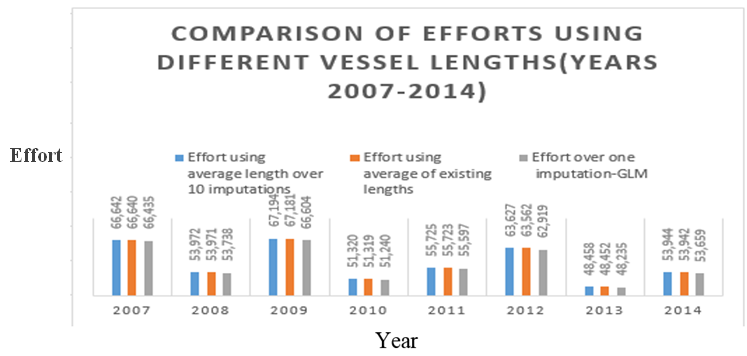 | Figure 5. Effort generated via GLM for the years 2007 through 2014 for different missing vessel length choices (one imputation, ten imputations or the average of existing vessel lengths) using the monotone regression imputation method |
|
3.2. Year as a Predictor
- The model with year as a predictor was fitted to the related Match file created earlier. Out of several parameters in the model, the following were not significant (p-value>0.05): area1, year4, and year6. The remaining parameters were significant with R-Squared=0.82 and Fstat = 16,832 and at p-value<0.0001. In order to measure the impact of using different imputation models used in this paper, efforts were generated using these models. Figure 6 displays the total effort estimates for a few imputation models defined in this paper.
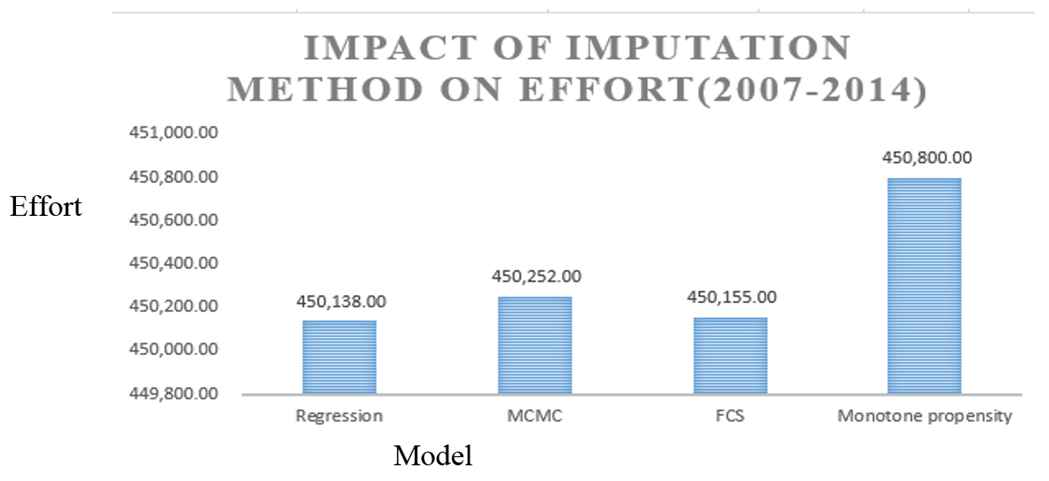 | Figure 6. Impact of imputation models on effort (year as a predictor): regression, MCMC, FCS, and monotone propensity |
|
|
|
|
4. Discussion
- The main objective of this work was to introduce the imputation method to the fisheries data and use it to estimate the missing data points in the Gulf of Mexico shrimp data files. The issue of missing data points was briefly addressed in [12] where imputation was deployed in handling such points. The contributor to the issue of missing data points was primarily the vessel length (length). One potential approach was to remove all the records with missing data points. This method has not been a popular approach among researchers as it reduces the sample size and results in a higher standard error (sample size n is in the denominator of the standard error formula). Alternatively, the missing data points could have been replaced with the average of the existing data points (Table 8 and Figure 5). For a comparison/contrast, this method was implemented here and the results were close to those of imputation. This was due to the low percentage of missing data points (Table 4). However, such substitution could have produced an estimate close to the actual value or something far away from it. As mentioned earlier, efforts in finding a simple or a multiple linear model between the known vessel lengths and variables such as pounds in the shrimp fisheries (2007-2014) did not produce a satisfactory result (R-Squared ranged from 0.03 to 0.08). Such relation, if satisfactory, could have been used to estimate the missing data points. Regression models with low R-Squared and high residuals would likely produce unreliable estimates. Reference [23] in his article argued that “Though the correlation coefficient, 0.18, differed significantly (P< 0.05) from zero, the correlation was not a strong one, and it was not considered to be of practical significance.” It was ultimately decided to deploy the imputation method in handling the missing vessel length values and other missing data points. Following the imputation of missing data points, a general linear model was developed and used to estimate shrimp effort in the GOM for the years 2007 through 2014. In the following, I will discuss the year-by-year and year as a predictor results respectively.
4.1. Year-by-year
- The analysis for the case where yearly data were analyzed separately suggested that the variable vessel length was statistically significant in the model estimating shrimp effort (p-value<0.0001) (See Table 6). Due to the low percentage of missing length, the estimated effort slightly changed when the model was run for different choices for the missing vessel lengths (Table 8 and Figure 5). To compare the impact of the ad-hoc methods and imputation, the model was run for different years using these methods. The analysis showed that the methods considered here generated about the same total effort per year (Table 8, Figure 5). Due to a low rate of missing vessel lengths and the closeness of the generated efforts, it was unrealistic to compare the impacts of imputation and ad-hoc methods. However, as mentioned earlier, the imputation method takes advantage of many features and produces a more reliable estimate (s) as displayed via an example earlier.
4.2. Year as a Predictor
- Similar to the case of year-by-year, the vessel length was a significant variable in the effort estimation model (tstat = -35.56, p-value < 0.0001) and the missing vessel lengths did not play a significant role in the estimation process due to the low percentage of missing values (Table 4). To measure the impact of different statistical imputation models on the shrimp effort estimation, four imputation models were deployed in the case of year as a predictor only (regression, MCMC, FCS, and monotone propensity). The monotone propensity model produced slightly higher towdays (662) over the period of eight years. As displayed in Table 12, Options I and II were placed in one category implying that the imputation of a few missing data points in either pounds or priceppnd fields did not play a significant role in the analysis.
5. Concluding Remarks
- In this research, a few imputation models for handling missing vessel lengths were discussed. As mentioned earlier, replacing the missing vessel lengths with the average of the existing vessel lengths could produce estimates far from the true values. Of course, when there are few missing values, most (if not all) methods would do well. However, there is no guarantee that this is always the case. There is a likelihood of facing a large number of missing data points. Therefore, one needs to explore all the possibilities and select the most appropriate method by considering the tradeoffs between the complexity and accuracy. Although the generated efforts were very close, among several imputation models presented in this paper, due to its flexibility, a monotone imputation is preferred assuming that the necessary condition (s) is satisfied. The analysis showed that the GLM model adequately represented the data sets in cases of year-by-year or year as a covariate. Reference [12] analyzed the same data using different statistical models. The model used in this article was much simpler involving fewer covariates. There is always a tradeoff between the complexity of the model and its accuracy or simplicity (Model parsimony). In this article, the main objective was to apply the imputation method to estimate missing data values in fisheries data. In both cases of year-by-year and year as a covariate, the missing vessel lengths did not significantly change the total effort due to the low percentage of missing values. The necessary normality condition for the error term in the model was checked using the empirical rule. In either case, it was concluded that the proposed model represented the data adequately and estimated the total effort within the expected range. Furthermore, analysis with year as a predictor versus year-by-year produced similar results. In addition, the efforts produced under different imputation models were similar with one model producing a slightly higher estimate.Although the application of the imputation method was limited to the shrimp data, it could be easily applied to other data sets. Missing data is common issue among data sets and this paper should be helpful in other areas of research.
ACKNOWLEDGEMENTS
- The author would like to thank Mr. James Primrose of NMFS for providing the data sets for this research, Drs. Ryan Kitts-Jensen and Alex Chester of NMFS, and anonymous referees for their excellent editorial comments.
Disclaimer
- The scientific results and conclusions, as well as any views or opinions expressed herein, are those of the author and do not necessarily reflect those of NOAA or the Department of Commerce.1. The term SEDAR stands for South East Data, Assessment, and Review and is the cooperative process established in 2002 by which stock assessment projects are conducted in NOAA Fisheries' Southeast Region. SEDAR was initiated to improve planning and coordination of stock assessment activities and to improve the quality and reliability of assessments (http://sedarweb.org).2. References to any software packages throughout this article do not imply the endorsement of the said products.
References
| [1] | Rubin, D. B. (1987). Multiple Imputation for Nonresponse in Surveys, New York: John Wiley & Sons, Inc. |
| [2] | Graybill, F. (1968). Theory and Application of Linear Model, Duxberry Classic Series. |
| [3] | He, Y. (2011). Missing Data Analysis Using Multiple Imputation: Getting to the heart of the Matter, HHS Public Access, 1-16. |
| [4] | Horton, N. J., Kleinman, K. P. (2007). Much ado about nothing: A comparison of missing data methods and software to fit incomplete data regression models, Am. Stat., 61(1), 79-90. |
| [5] | Graham, J. W., Hofer, S. M., Donaldson, S. I., MacKinnon, D. P., Schafer, J. L. (1997). Analysis with missing data in prevention research. In K. Bryant, M., Windle, S. West (Eds.), The science of prevention: methodological advances from alcohol and substance abuse research. |
| [6] | Wayman, J. C. (2002). The utility of educational resilience for studying degree attainment in School dropouts. Journal of Educational Research, 95 (3), 167-178. |
| [7] | Schafer, Olsen, M. K. (1998). Multiple imputation for multivariate missing-data problems: A data analyst’s perspective. Multivariate Behavioral Research, 33 (4), 545-571. |
| [8] | Graham, Hofer, S. M. (2000). Multiple imputation in multivariate research. In R. J. Little, K. U. Schnabel, J. Baumert (Eds.), Modeling longitudinal and multiple-group data: Practical issues, applied approaches, and specific examples. Erlbaum, Hillsdale. |
| [9] | Sinharay, S., Stern, H. S., Russell, D. (2001). The use of multiple imputation for the analysis of missing data. Psychological Methods, 6 (4), 317-29. |
| [10] | Griffin, W. L., Shah, A. K., Nance, J. M. (1997). Estimation of Standardized Effort in the Heterogeneous Gulf of Mexico Shrimp Fleet, Marine Fisheries Review, (59) 3, 23-33. |
| [11] | Hart R. A., Nance, J. M. (2013). Three Decades of U.S. Gulf of Mexico White Shrimp, Litopenaeus setiferus, Commercial Catch Statistics, Marine Fisheries Review, 75 (4), 43-47. |
| [12] | Marzjarani, M. (2016). Higher Dimensional Linear Models: An Application to Shrimp Effort in the Gulf of Mexico (Years 2007-2014), International Journal of Statistics and Applications 2016, 6(3), 96-104. |
| [13] | Reid D. G., Graham N., Rihan D. J., Kelly E., Gatt, I. R., Griffin, F., Gerritsen, H. D., Kynoch, R. J. (2011). Do big boats tow big nets? ICES Journal of Marine Science, 68(8), 1663–1669. doi:10.1093/icesjms/fsr130. |
| [14] | Raghunathan, T. (2016). Missing Data Analysis in Practice, CRC Press. |
| [15] | Little, R. J. A. (1988). A test of missing completely at random for multivariate data with missing values. Journal of the American Statistical Association. 83 (404), 1198-1202. |
| [16] | Schmitt, P., Mandel, J., and Guedj, M. (2015). A Comparison of Six Methods for Missing Data Imputation, J Biom Biostat 6:224. doi: 10.4172/2155-6180.1000224. |
| [17] | Yuan, Y. (2011). Multiple Imputation Using SAS Software, Journal of Statistical Software, Vol. 45, Issue 46, pp. 1-25. |
| [18] | Rosenbaum, P. R., Rubin, D. B. (1983). “The Central Role of the Propensity Score in Observational Studies for Causal Effects.” Biometrika, 70, 41–55. |
| [19] | Schafer, J. L. (1997). Analysis of Incomplete Multivariate Data, New York: Chapman and Hall. |
| [20] | Allison, P. D. (2000). “Multiple Imputation for Missing Data: A Cautionary Tale” Sociological Methods and Research, 28, 301–309. |
| [21] | van Buuren, S., Boshuizen, H. C., Knook, D. L. (2007). “Multiple Imputation of Missing Blood Pressure Covariates in Survival Analysis” Statistics in Medicine, 18, 681–694. |
| [22] | Rubin (1996). Multiple Imputation after 18+ Years, Journal of the American Statistical Association, Vol. 91, No. 434, 473-489. |
| [23] | Patella, F. (1975). Water surface area within statistical subarea used in reporting Gulf coast shrimp data. Mar. Fish. Rev. 37(12), 22–24. |
 Abstract
Abstract Reference
Reference Full-Text PDF
Full-Text PDF Full-text HTML
Full-text HTML